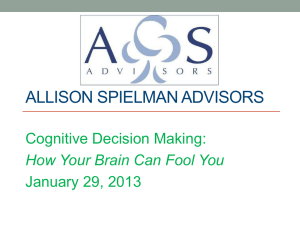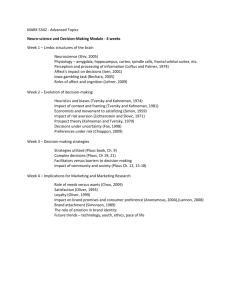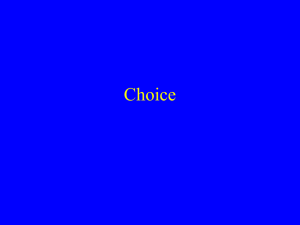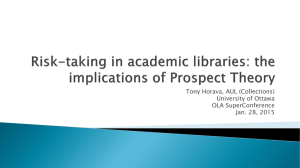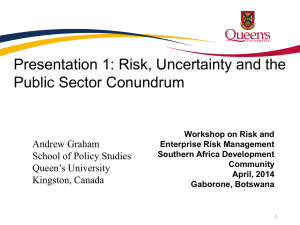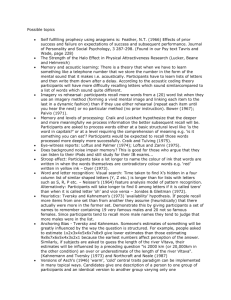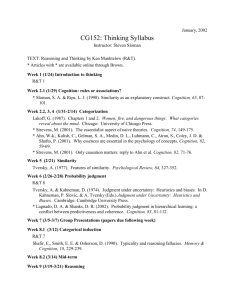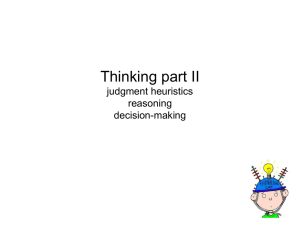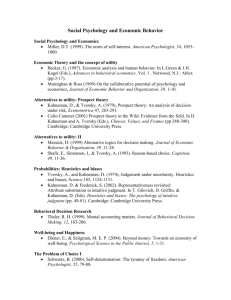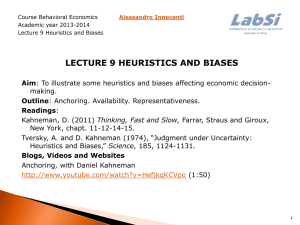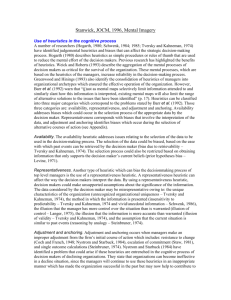negot-class2
advertisement
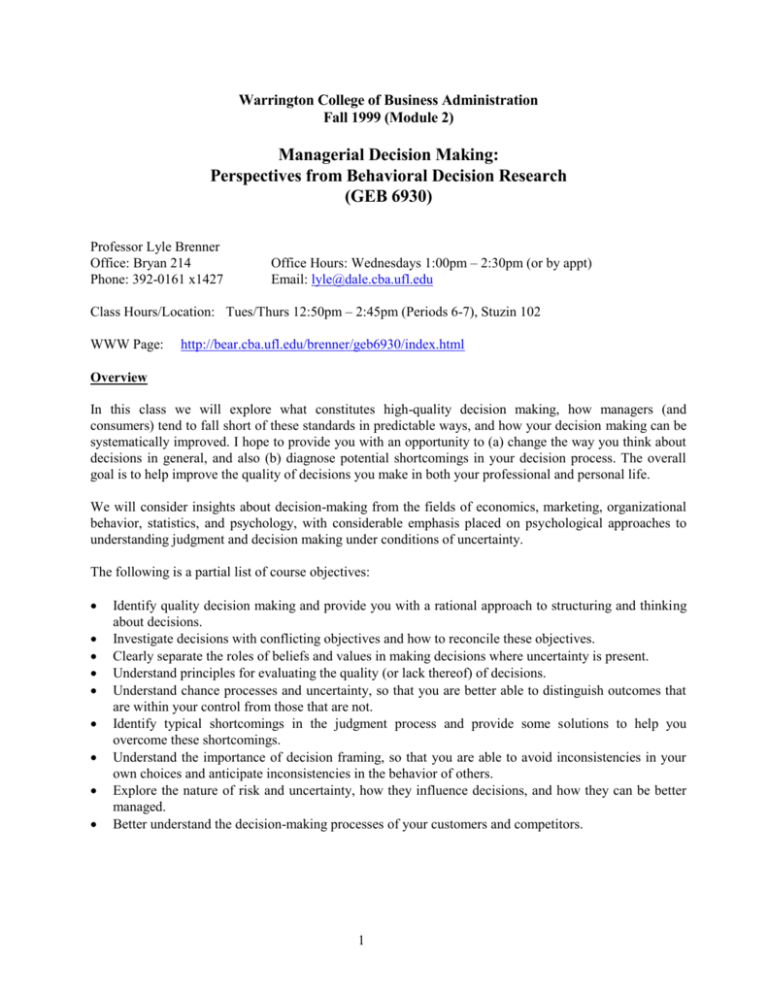
Warrington College of Business Administration Fall 1999 (Module 2) Managerial Decision Making: Perspectives from Behavioral Decision Research (GEB 6930) Professor Lyle Brenner Office: Bryan 214 Phone: 392-0161 x1427 Office Hours: Wednesdays 1:00pm – 2:30pm (or by appt) Email: lyle@dale.cba.ufl.edu Class Hours/Location: Tues/Thurs 12:50pm – 2:45pm (Periods 6-7), Stuzin 102 WWW Page: http://bear.cba.ufl.edu/brenner/geb6930/index.html Overview In this class we will explore what constitutes high-quality decision making, how managers (and consumers) tend to fall short of these standards in predictable ways, and how your decision making can be systematically improved. I hope to provide you with an opportunity to (a) change the way you think about decisions in general, and also (b) diagnose potential shortcomings in your decision process. The overall goal is to help improve the quality of decisions you make in both your professional and personal life. We will consider insights about decision-making from the fields of economics, marketing, organizational behavior, statistics, and psychology, with considerable emphasis placed on psychological approaches to understanding judgment and decision making under conditions of uncertainty. The following is a partial list of course objectives: Identify quality decision making and provide you with a rational approach to structuring and thinking about decisions. Investigate decisions with conflicting objectives and how to reconcile these objectives. Clearly separate the roles of beliefs and values in making decisions where uncertainty is present. Understand principles for evaluating the quality (or lack thereof) of decisions. Understand chance processes and uncertainty, so that you are better able to distinguish outcomes that are within your control from those that are not. Identify typical shortcomings in the judgment process and provide some solutions to help you overcome these shortcomings. Understand the importance of decision framing, so that you are able to avoid inconsistencies in your own choices and anticipate inconsistencies in the behavior of others. Explore the nature of risk and uncertainty, how they influence decisions, and how they can be better managed. Better understand the decision-making processes of your customers and competitors. 1 Required Readings Russo, J.& Schoemaker, P. (1990). Decision Traps: The Ten Barriers to Brilliant Decision-Making and How to Overcome Them. New York: Fireside. (R&S) Hammond, Keeney, & Raiffa (1999). Smart Choices: A Practical Guide to Making Better Decisions. Boston: Harvard Business School Press. (HKR) Reading Packet (Available at Target Copy, 22 NW 13th St.) 1. Einhorn, H. & Hogarth, R. (1987). Decision making: going forward in reverse. Harvard Business Review, Jan-Feb 1987, 66-70. 2. Tversky, A. & Gilovich, T. (1989). The cold facts about the “hot hand.” Chance, 2, 16-21. 3. Dawes, R. (1979). The robust beauty of improper linear models. American Psychologist, 34, 571-582. (reprinted in KST, Chapter 28) 4. Tversky, A. & Kahneman, D. (1974). Judgment under uncertainty: Heuristics and biases. Science, 185, 1124-1131. (reprinted in KST, Chapter 1) 5. Keeney, R. (1994). Creativity in decision making with value-focused thinking. Sloan Management Review, Summer 1994, 33-41. 6. Kahneman, D., Knetsch, J. & Thaler, R. (1990). The endowment effect, loss aversion, and the status quo bias. Journal of Economic Perspectives, 5, 193-206. 7. Kahneman, D. & Tversky, A.(1984). Choices, values, and frames. American Psychologist,39, 341-350. 8. Thaler, R. (1985). Mental accounting and consumer choice, Marketing Science,4, 199-214. 9. Kahneman, D. & Lovallo, D. (1993). Timid choices and bold forecasts: A cognitive perspective on risk-taking. Management Science, 39, 17-31. 10. Simonson, I. (1993). Get closer to your customers by understanding how they make choices. California Management Review, 35, 68-84. Note: Several of the assigned readings and many articles others of interest are collected in the following recommended but optional edited volume: Kahneman, D., Slovic, P., & Tversky, A. (1982). Judgment under uncertainty: Heuristics and biases. Cambridge: Cambridge University Press. (KST) 2 Course Requirements 1. Class Participation (25%) As usual, quality of your contribution is valued more than quantity. Yes, there will be cold calling. Attendance is naturally very important. Criteria for your participation grade will include: a) Attendance b) Preparation for discussions c) Quality of comments in class discussions d) Thoughtfulness of work done in class exercises 2. Short Weekly Written Assignments (25%) Throughout the module, you will submit brief written answers to questions posed in class. (Each will be one-page, 400 words maximum, and you will include the word count on the page.) You will get one freebie: i.e., you’ll get to drop your lowest score for these assignments. 3. Paper: Topic Illustration (25%) Before December 3 you will submit a short paper (1500 words maximum), illustrating one or more concepts covered in class or in the readings. The content of the paper is up to you -- it may be drawn from your professional, educational, and personal experiences, or from the media. For an illustration drawn from the media, you will find a newspaper or magazine article, excerpt from a book, or a video tape segment from a film or television show, etc. that illustrates one or more principles from class or the readings, and discuss and analyze its relevance to material that we cover in this course. The topic illustration will be graded based on the validity, quality, clarity, and insightfulness of your description and analysis, as well as the “interestingness” and/or importance of the example chosen. The topic illustration is due by 5:00 pm on December 3 -- no exceptions! 3. Final Exam (25%) The final exam (Tuesday, December 14, 12:50--2:45pm) will be a straightforward exam that will test your understanding of basic concepts and tools from class and the readings. 3 Approximate Schedule of Topics I will assume that you have read the relevant material prior to coming to class. I will often direct your attention to the most important parts of the assigned readings. The composition and order of topics below is only a guideline; we may deviate from it as circumstances and evolving interests of the class dictate. Topics and Themes Readings Introduction: A framework for thinking about decisions What makes decisions easy/hard/good/bad? Descriptive, normative, and prescriptive approaches R&S Intro, Ch 1 HKR Ch 1, 2 Chance, control, and learning from experience Looking forward and back (Mis)perceptions of chance Illusory correlation Learning about cause and effect R&S Ch 8, 9 Tversky & Gilovich Einhorn & Hogarth Looking ahead: Prediction and probability judgment Intuitive and model prediction Heuristics and biases; overconfidence R&S Ch 4, 5; Dawes Tversky & Kahneman (1974) Building decisions: Frames and values Framing; status quo and endowment effects Creativity in problem structuring R&S Ch 2, 3; Kahneman et al; Keeney; HKR Ch 3, 4 Decision making under uncertainty Integrating beliefs and values; Expected utility theory Prospect theory; loss aversion; nonlinear decision weights R&S Ch 6 Kahneman & Tversky (1984) Applications of prospect theory Mental accounting Isolation errors Thaler Kahneman & Lovallo Reasons, conflict, and consumer choice Reason-based choice Conflict and tradeoffs Context effects Simonson HKR Ch 5, 6 Other Topics Group decision making Decision making over time Ethical Issues R&S Ch 7 HKR Ch 9 4
